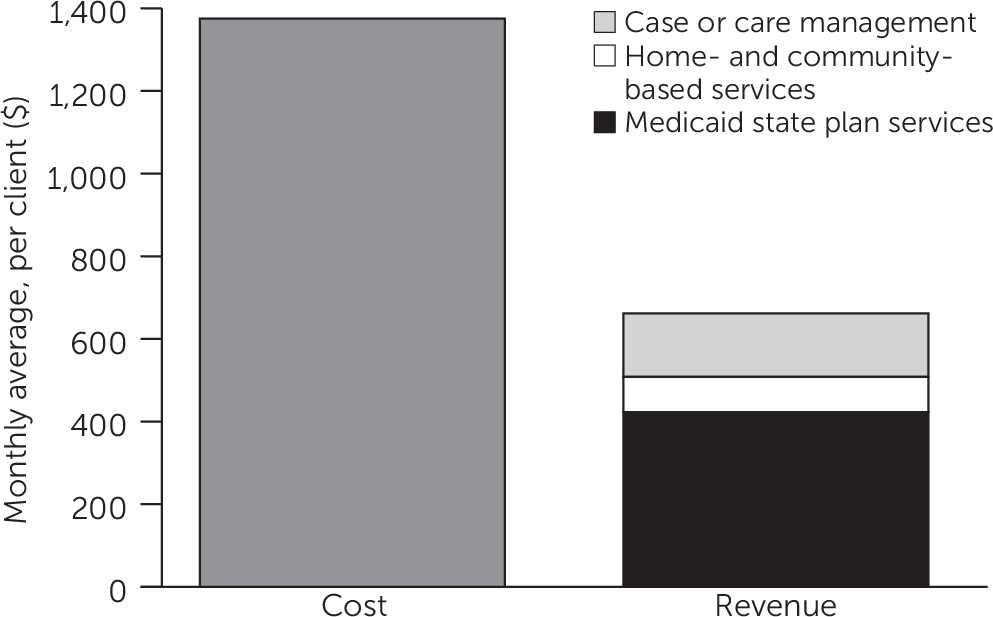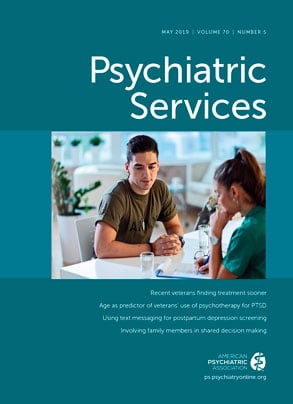Multiple studies have documented the benefits of intensive team-based services for clients early in the course of a psychotic disorder (
1,
2). In response, the National Institute of Mental Health developed the coordinated specialty care treatment model, which includes a multidisciplinary team providing psychotherapy, medication management, family education and support, case management, and work or education support (
3). This model is the foundation for nationwide efforts to support early intervention services for clients with first-episode psychosis, and as of 2017, 48 states implemented or planned to implement such programs (Heinssen R, personal communication, 2017).
A major obstacle to widespread implementation of coordinated specialty care is the lack of established funding streams. Some of the services in the model, such as psychiatric assessment, medication management, and individual and family psychotherapy, are covered by commercial insurance as well as Medicaid. Case management and peer, employment, and educational supports, however, are typically not covered by insurance programs. There is interest in developing monthly per-person case rates for coordinated specialty care, but little data exist regarding the combinations of services usually provided by teams, the costs of these services, and the reimbursement levels needed to cover them. This column describes an effort to understand how much time coordinated specialty care team members spend providing reimbursable versus nonreimbursable services and attempts to estimate the amount of program costs that could be covered given optimal billing for services.
Methods
The OnTrackNY program for New York State residents with first-episode psychosis.
The New York State OnTrackNY program was first implemented in 2013 and provides coordinated specialty care to youths and young adult New York State residents who are within 2 years of the onset of nonaffective psychosis (
4,
5). As of 2018, 21 teams were operating throughout New York State, serving 696 clients. In addition to providing routine clinic services, such as medication management and individual and group psychotherapy, OnTrackNY programs provide education, employment, and family support along with assertive outreach, peer support, and psychosocial rehabilitation services. New York State had received approval from the Centers for Medicare and Medicaid Services to allow Medicaid reimbursement for these “home- and community-based services” for high-need clients, and at the time of this study, the state was developing procedures to include clients with first-episode psychosis as an eligible population. The team-based model also includes significant case management and staff consultation activities that do not have an established funding mechanism.
Time study data collection.
The study team randomly selected 78 clients from a list of all Medicaid clients enrolled in 13 sites providing coordinated specialty care during an identified 2-week period in June 2017. The 13 sites were chosen because they had been in operation for more than 12 months, thereby limiting the impact of clinic start-up activities on the time study data. Medicaid-enrolled clients were selected because they accounted for 51% of all clients served in the programs and because the study team had access to New York State Medicaid billing codes to estimate revenues. The study team used a stratified random selection procedure to identify six clients from each site: two each in the early phase of care (enrolled in the coordinated specialty care clinic less than 4 months), intermediate phase (enrolled for 5–8 months), and extended phase (enrolled for at least 9 months). If a site did not have two Medicaid clients in each of the three phases, clients from other phases were sampled to reach the total of six clients. Three sites had only five Medicaid clients enrolled in care (all phases combined) during the identified period, leaving a final total sample of 75 clients.
Each site was given a daily activity log template to document all activities provided to each identified client during the 2-week study period. Clinic staff members were instructed to document all billable and nonbillable activities for the identified clients including care and case management and administrative activities (e.g., supervision, case conferences, and record keeping). Each site’s program director reviewed the daily logs for accuracy and entered the data into a client activity record. Data from the daily activity logs and client activity records were imported into a database that included the clinic site name and each client’s age, service dates, credentials of staff person completing each activity, time spent on each activity, location and whether the activity was conducted face to face with the client, a brief service or activity description, and a Current Procedural Terminology (CPT) or home- and community-based service code if the clinic was billing or thought it could have billed for that activity.
Data management and analysis.
Staff members from the 13 clinics reported a total of 528 specific activities completed for the 75 selected clients during the 2-week study period. The study team determined that staff activities could be grouped into four categories: Medicaid state plan reimbursable services (e.g., medication management, individual and group psychotherapy); activities reimbursable under the state’s Medicaid waiver for home-and community-based services, including peer, family, educational, and employment support; care and case management, including outreach and telephone coordination with enrolled clients, family, and outside treatment providers (these activities are reimbursable in New York State only for clinics designated as Health Home care management agencies, which did not include any of the OnTrackNY clinics); and administrative activities that are not reimbursable, such as staff supervision, case conferences, and medical record documentation.
Two members of the study team independently reviewed and assigned each activity to one of the four categories. All CPT codes provided by the teams were reviewed and confirmed or changed to ensure that the database would estimate revenues with optimal billing (codes were assigned according to the highest reimbursement rate that could be justified based on the activity described). Add-ons and quality adjustments available in the state’s Medicaid program were also applied wherever applicable. A client mix factor was used to estimate monthly time allocations and Medicaid revenue generated for each team. The client mix factor was meant to account for the distribution of each team’s total caseload of Medicaid clients across the three phases of care (early, intermediate, and extended). Average costs to operate a clinic team were obtained from budgets submitted from the first seven sites opened under the state’s OnTrackNY initiative, all of which participated in the time study. These seven original sites were required to submit budgets comprising full operational costs of the program (similar data were not available from the other six sites).
Results
Of time staff members spent completing activities related to the identified clients, 57% involved Medicaid state plan reimbursable services. Another 15% of staff time was spent providing reimbursable home- and community-based services, 13% was spent providing case and care management, and 15% was spent on nonreimbursable administrative activities. (See the online supplement for a table listing the caseloads and time allocations for each of the 13 teams.) There was considerable variability across teams, especially regarding time spent providing home- and community-based services. Two sites reported spending no time providing these peer, education, and employment support services to the identified clients, whereas another site reported that 48% of staff time was spent providing these services during the 2-week study period. Supplement Table 1 also indicates that on average, 72% of staff time completing activities related to the identified clients was dedicated to Medicaid billable services.
Figure 1 shows estimated costs and revenues for Medicaid clients with first-episode psychosis from the seven sites that reported cost data (detailed data for each of the seven sites are included in Supplement Table 2). The mean±SD cost for the teams was $1,375±$335 per client per month. Estimated Medicaid revenues under optimal billing included $423 per client per month from state plan services and $85 per client per month for home- and community-based services. OnTrackNY clinics are not authorized to bill for care or case management services in New York State, but for comparison with states that do allow clinics to bill for care and case management,
Figure 1 includes an estimate for monthly care management revenue from the state’s Health Home program ($154 per client per month). Thus, under optimal billing conditions including reimbursement for care management activities, the clinic teams would generate an estimated $662 per client per month, only 48% of average costs.
Discussion and Conclusions
In the coordinated specialty care model, individuals with first-episode psychosis vary in their use of specific services over time depending on the severity of the illness, acuity of symptoms, and desire to use education or employment supports. This variability makes it difficult for coordinated specialty care programs to forecast revenues for both billable and nonbillable services and underscores the importance of data such as those reported herein. Our findings indicated significant variation across sites in the categories of service activities provided, which is likely to reflect the coordinated care model’s emphasis on individualized, person-centered care planning. The variation also could be due to different populations of clients served across sites, site-level variation in implementation of the treatment model, or inconsistent reporting of activities despite the extensive staff orientation and training, along with our rigorous approach to reviewing submitted data. We are not aware of other similar studies that allow for comparison of these variations across sites.
This time study identified both inadequate coverage and insufficient reimbursement of Medicaid services for individuals receiving coordinated specialty care in a fee-for-service environment. Seventy-two percent of team staff members’ effort was spent providing services that were reimbursable via either the Medicaid state plan or home- and community-based waiver programs. When potential care management revenues were added, 85% of the total staff time for completing activities related to the identified clients was estimated to generate only 48% of the total monthly costs to serve an individual with first-episode psychosis. These data indicate that policy makers and payers will likely need to consider either ongoing subsidies to coordinated specialty care programs or increased rates for specific reimbursable services. Both of these options are unreliable and complex because they involve regulatory as well as political considerations that are difficult to predict and manage.
Our data support expert recommendations that payers and policy makers should consider monthly case rates for coordinated specialty care (
6). The per-client monthly cost estimate for coordinated specialty care in this time study is similar to proposed costs and case rates suggested by advocates, although further efforts are needed to clarify these costs. More rigorous cost studies should also aim to account for staff activities that are not client specific but essential to the coordinated specialty care model such as outreach to referral sources, screening referrals, and participation in training activities. In the meantime, payers and policy makers should continue to preserve existing subsidies to support dissemination of an important new model of early intervention care for a vulnerable and deserving population.
Acknowledgments
Dr. Bao is supported by a grant from the Systems for Action program of the Robert Wood Johnson Foundation. The authors thank Nehreen Spiezio and Gwen Diamond for their assistance with analyzing study data.


